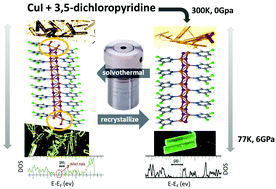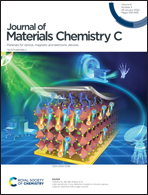Cunning defects: emission control by structural point defects on Cu(i)I double chain coordination polymers†
Abstract
The direct reaction between CuI and 3,5-dichloropyridine, in acetonitrile at room temperature, gives rise to [Cu(Cl2-py)I]n (Cl2-py = 3,5-dichloropyridine), which consists of a Cu(I)–I double chain based coordination polymer (CP) grafted with 3,5-dichloropyridine. In this simple one-pot process, the modulation of the reaction conditions, i.e. slight variations in the CuI and Cl2-py ratio caused by in situ disproportion, can, however, produce significant changes in the physical properties of the materials. For instance, the reaction carried out in a 1 : 1 ratio under ambient conditions leads to compound 1, while compound 1′ is obtained upon a solvothermal process of stoichiometric reaction mixture, Cl2-py and CuI, which produces partial disproportion (<0.5% in weight) of the initial Cu(I). Interestingly, compounds 1 and 1′ show an identical chemical composition and structure as determined by both single crystal and powder X-ray diffraction. However, they display remarkable differences in the luminescence behavior, featuring broad emission bands centered at 515 and 670 nm and associated to photoluminescence quantum yields of 12 and 5% for 1 and 1′, respectively. Density functional theory (DFT) calculations allowed us to rationalize the nature of this rare behavior. This is attributed to structural defects related to the weaker coordination bond present in these structures that provoke the strong red-shifted emission.



 Please wait while we load your content...
Please wait while we load your content...